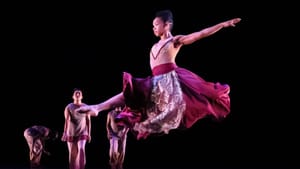Stay in the Loop
BSR publishes on a weekly schedule, with an email newsletter every Wednesday and Thursday morning. There’s no paywall, and subscribing is always free.
Connection and collaboration
NextMove Dance presents Ronald K. Brown/Evidence, a Dance Company

NextMove Dance brought Ronald K. Brown/Evidence, a Dance Company to Philadelphia from Brooklyn, with four dances spanning 20 years of artistic director Brown’s choreography. These include Torch (2013), Ebony Magazine: To a Village (1996), Four Corners (2014), and the Philadelphia premiere of New Conversations: First Look (2017). The company includes seven dancers, all of whom appear in each dance. One of these pieces, New Conversations, was created in collaboration with Arturo O’Farrill, a Grammy-winning composer of Afro-Latin jazz.
Cultural exchange
NextMove performances begin with remarks from the artists, and before the show began Brown described his artistic mission as incorporating — but not appropriating — African traditions. He emphasized cultural exchanges between the United States, African nations, and Cuba, which he believes contribute to the ability of contemporary dance to reflect the human condition.
Brown’s use of varied elements of music and movement, from the sounds of electronica and spoken word to movement from Ivory Coast and New York, made effective connections between cultures and traditions. The mixed program demonstrated that contemporary dance indeed has the potential to allow audiences to see themselves in movement onstage.
The first piece, Torch, began with images of suffering. Dancers appeared in costumes resembling choir robes, while R&B-inflected gospel vocals pleaded for deliverance. Movements evocative of baptism suggested potential for relief. Torch’s middle sections, set to electronic music with religious lyrics, contained choreography which suggested the ways people worship together and alone. The crowd-pleasing final section incorporated African dance and sensual movement to reflect joy and empowerment, though its link to the piece’s earlier portions of were unclear.
The next dance, Ebony Magazine: To a Village, addressed the theme of bearing witness, individually and together, in and out of sync. This piece is more than 20 years old but remains remarkably contemporary. Musical refrains helped to organize the dance, with the phrases “Do you see what I see?” and “African Twilight Zone” calling to mind video-recorded violence against black Americans, from Rodney King to Eric Garner.
A middle portion of the piece contained spoken-word poetry addressing cultural alienation and the potential for finding hope and authenticity in family, silence, and contemplation. The opening sequence of Ebony Magazine: To a Village provided the clearest and most powerful representation of its themes, with dancers moving together and alone at different speeds to illustrate the ways humans see and feel.
Return to form
Hopes were high for the local premiere, New Conversations, which contained original music composed by Arturo O’Farrill. This piece was pleasant and well executed, and it elicited a few cheers. New Conversations also effectively fused features from jazz, hip hop, and African dance, yet it was not as stirring as the other works in the program, perhaps because it is hard to see the company’s vision in the piece.
However, Four Corners, commissioned by the Alvin Ailey American Dance Theater, concluded the evening on a high note. A song with lyrics about roses and thorns returned to expressing humanity through contemporary dance, and the movement reflected this. Four Corners contained a solo of particular grace and beauty, along with visually compelling shifts between sections that invited exploration of life’s transitions and pauses.
Altogether, this performance by Ronald K. Brown/Evidence provided much evidence of connection and collaboration between genres and styles and between dancers and audience. It clearly demonstrated contemporary dance’s possibilities for relevant expression in the 21st century.
What, When, Where
Ronald K. Brown/Evidence, A Dance Company. Choreography by Ronald K. Brown. NextMove Dance. December 14-17, 2017, at the Prince Theater, 1412 Chestnut Street, Philadelphia. (215) 422-4580 or princetheater.org/next-move.
Sign up for our newsletter
All of the week's new articles, all in one place. Sign up for the free weekly BSR newsletters, and don't miss a conversation.

 Melissa Strong
Melissa Strong